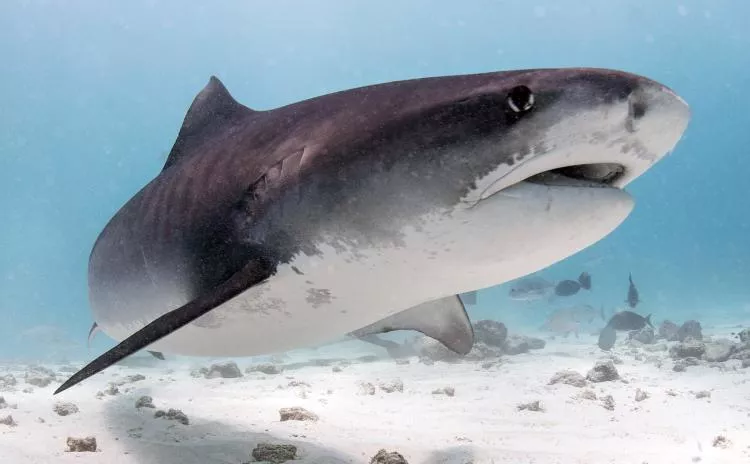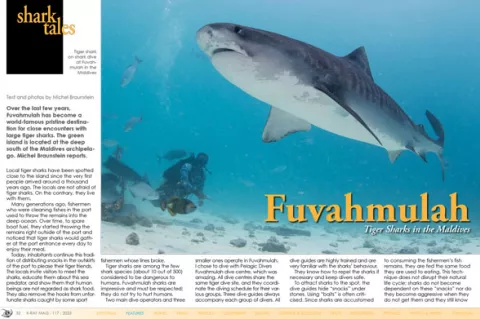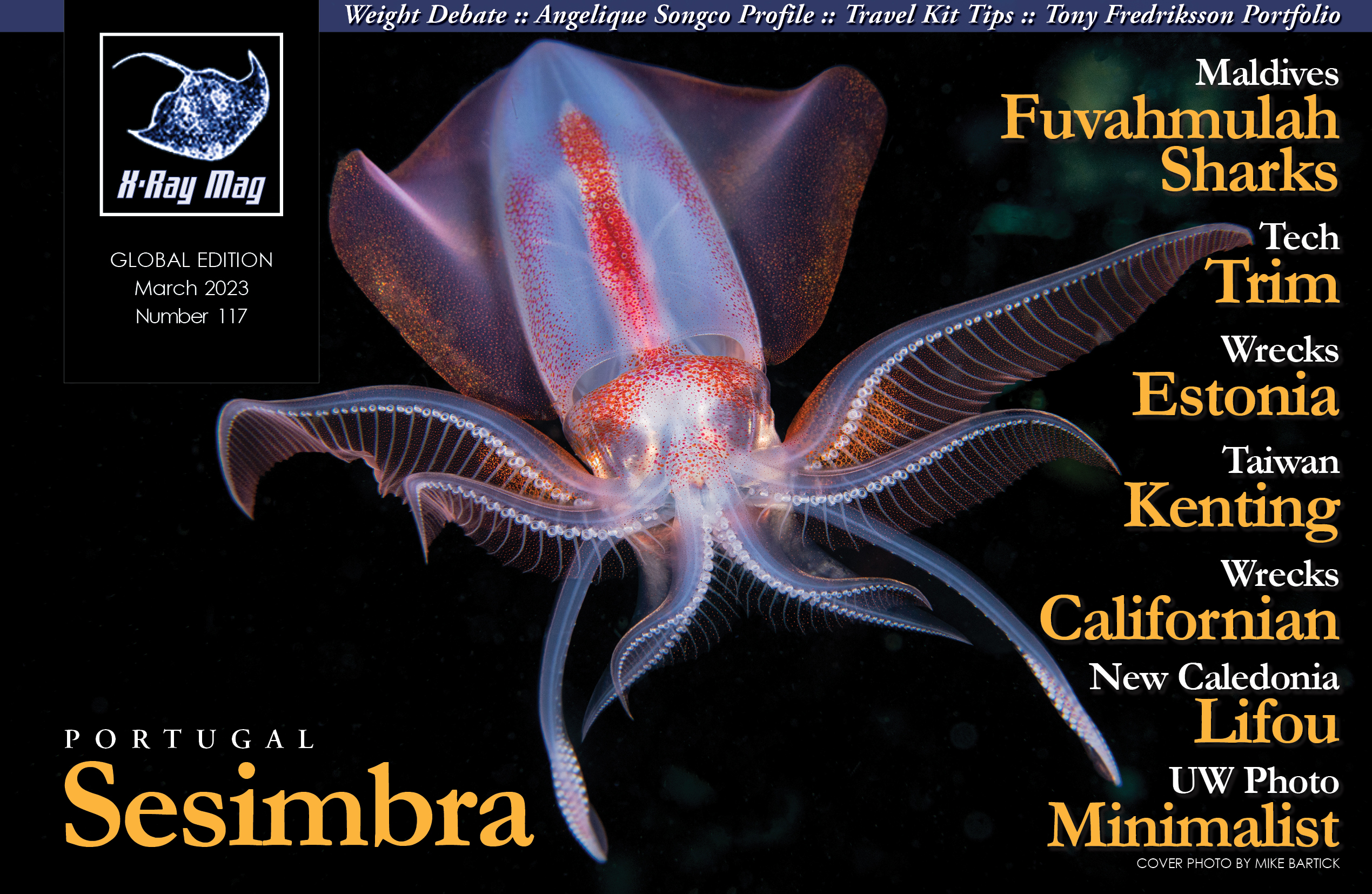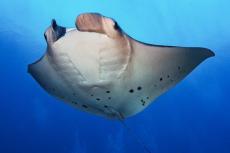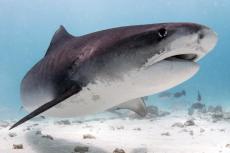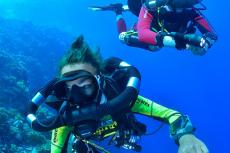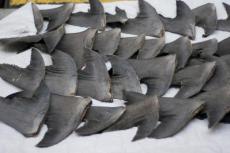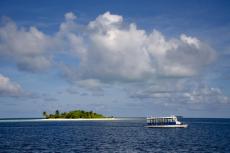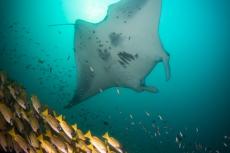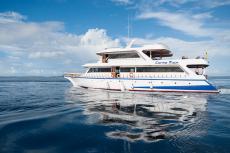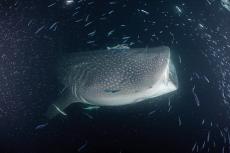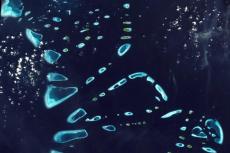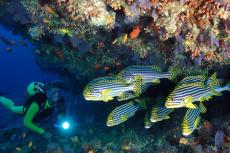Over the last few years, Fuvahmulah has become a world-famous pristine destination for close encounters with large tiger sharks. The green island is located at the deep south of the Maldives archipelago. Michel Braunstein reports.
Contributed by
Local tiger sharks have been spotted close to the island since the very first people arrived around a thousand years ago. The locals are not afraid of tiger sharks. On the contrary, they live with them.
Many generations ago, fishermen who were cleaning fishes in the port used to throw the remains into the deep ocean. Over time, to spare boat fuel, they started throwing the remains right outside of the port and noticed that tiger sharks would gather at the port entrance every day to enjoy their meal.
Today, inhabitants continue this tradition of distributing snacks in the outskirts of the port to please their tiger friends. The locals invite visitors to meet the sharks, educate them about this sea predator, and show them that human beings are not regarded as shark food. They also remove the hooks from unfortunate sharks caught by some sport fishermen whose lines broke.
Tiger sharks are among the few shark species (about 10 out of 500) considered to be dangerous to humans. Fuvahmulah sharks are impressive and must be respected; they do not try to hurt humans.
Two main dive operators and three smaller ones operate in Fuvahmulah. I chose to dive with Pelagic Divers Fuvahmulah dive centre, which was amazing. All dive centres share the same tiger dive site, and they coordinate the diving schedule for their various groups. Three dive guides always accompany each group of divers. All dive guides are highly trained and are very familiar with the sharks’ behaviour. They know how to repel the sharks if necessary and keep divers safe.
To attract sharks to the spot, the dive guides hide “snacks” under stones. Using “baits” is often criticised. Since sharks are accustomed to consuming the fishermen’s fish remains, they are fed the same food they are used to eating. This technique does not disrupt their natural life cycle; sharks do not become dependent on these “snacks” nor do they become aggressive when they do not get them and they still know how to feed themselves in the ocean. Using “snacks” simply facilitates observation and the interaction with the predators, so that the divers can get to know and understand them. Most importantly, it shows that the sharks are not killers, as often falsely portrayed in popular movies and tabloids. Finally, and as previously stated, this technique also enables the removal of painful items from sharks such as hooks, ropes or nets.
Tiger sharks are beautiful creatures, and they can make your dive experience highly moving and unique. Fuvahmulah is one of the only places in the world where sharks can be approached and observed with so much ease. Most sharks are local and are given first names. At times, new visitors or new pups join the family. Diving with Fuvahmulah’s tigers is quite easy and takes place at a shallow, 10-metre (30 feet) depth.
The dive experience
During the pre-dive briefing, our dive guide Ina explained that there are three guides with the group to keep a proper overall watch of both divers and sharks during the dive; however, it is also set up in case there is any incident, so one of the guides can pull the victim back to the boat, while the second one repels the sharks if necessary, and the third one takes the rest of the dive group to finish the dive close to the reef. That was not really encouraging…
We left the small port of Fuvahmulah, and after a ten-minute boat ride, we reached the dive site, just outside the port. Our divemaster told us to be negatively buoyant while entering the water and to start descending immediately after jumping in. The reason for this was to prevent curious tiger sharks from coming too close to see if there was any interesting fish to taste. Well, that made me a little bit unsure of how to proceed, as I could not descend immediately, since I had to wait for someone on the boat to give me my big camera rig. It all happened quite fast though, with no issues.
We started to descend to the location we were aiming for, and I noticed a huge tiger shark swimming next to us in the blue. It was heading for the same location, where it apparently knew there would be some interesting snacks.
When we arrived at the spot, we waited a moment for the previous group to leave, then took their places. We placed ourselves in a line. In the middle of the sandy area, Ina was waiting for the boat to send down a bucket with some fishtails. He placed the snacks under some heavy stones, and the tiger sharks came close to get them out. There were six or seven that turned around, went away, then came back again. When they went too close to Ina, he repelled some sharks by pushing them back on their snoots (noses).
The older ones, which were also bigger (up to 5.7m), knew the game well; they had developed some skills to get the snacks out from under the stones. For the younger ones (3m long), it was still quite new, and they did not know exactly how to proceed.
We watched this ballet of sharks, which was breathtaking. These animals were impressive. They were quite slow and did not pay too much attention to the divers. They deserved a lot of respect, and we needed to avoid making them take an aggressive attitude.
On my second dive day, Ina came to take me from the side where I was in line with all the divers, and he brought me to the center of the playground. Wow, that was quite thrilling! I could almost touch the sharks, or they could touch me, because they were so close.
It was an unforgettable and incredibly exciting experience. I will surely go back again as soon as I can!
Other underwater attractions
Besides the amazing tiger sharks, Fuvahmulah offers other beautiful underwater attractions. The reefs are beautiful, and make good supplemental dives to complement your shark dives. Thresher sharks may be spotted (though not on every dive) at deep cleaning stations between 40 to 50m deep. They must be approached very slowly because they are very shy and swim rapidly into the depths. Under the right conditions, you may encounter awesome schools of scalloped hammerhead sharks in the current. There are also whale sharks.
Black oceanic manta rays can be spotted around the cleaning stations all year round, especially during their mating season between March and May. Whitetip sharks and grey reef sharks can be seen quite often. Depending on the season, you can also see schools of barracudas, yellowfin tunas, sailfish, mola mola, whales and more.
Topside excursions
After dives, there are also some cool things to do. The dreamy Thoondu beach is a must. Do not miss it if you are on the island. There is also Bandaara Kilhi and Dhadimago Kilhi, two beautiful freshwater lakes on the island, which are great for hiking. They are also where you can spot many species of birds and freshwater fish.
There is a cool mud place you can enter (preferably not with your favourite swimsuit). It is supposed to be very healthy for the skin. You can also visit some pre-Islamic historical sites. In addition, there are splendid spots where you can surf or paddle. In the very hip pub called “Led Zeppelin,” you can enjoy succulent meals and a nice atmosphere. For transport between places, it is very convenient to rent a scooter.
More about the location
The island is in the deep south of the Maldives, about a 70-minute flight from Mal. It also has its own domestic airport, which makes it easy to reach. Usually, planes stop on another island on the way, which extends the flight time.
There are 14,000 inhabitants divided in eight different districts, which makes it the second-largest population hub in the Maldives. The locals speak a dialect that is unique to the island and distinctive of the official Maldivian Dhivehi language.
The island’s economy relies mostly on fishing and agriculture. It is the biggest producer of mango and banana in the country. Maldivian Rufiyaa is the official currency, but US dollars and Euros are accepted everywhere.
There are some hotels in Fuvahmulah, including Tiger Shark Residence, a nice guest house close to nature, and Atraxis, a more modern and international hotel. Electrical power plugs are UK-style, like all over the Maldives.

